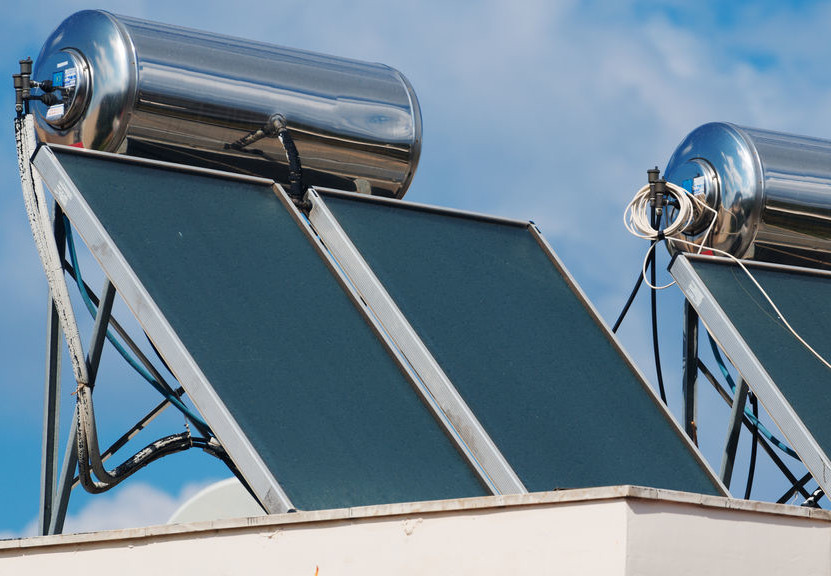When it comes to solar panels, most of us tend to think of the large blueish panels, dotted with solar cells, that provide us with free electricity. Personally, I have a small array of my own and they make me smile every time I look at them.
But the beautiful reality of solar is that it can do more than just provide us with electricity, it can provide us with heat as well.
In locations where there is ample supply of reliable sunshine and moderate to warm year round temperatures (think Mediterranean), household hot water is commonly produced by the sun.
In other locations, where warm weather is less common, solar panels can be used to heat air in order to raise the temperature of your home.
And for those of you who really like your gadgets, solar panels can even produce enough heat to cook your food.
In fact, as one really dives into what solar panels can do, it doesn’t take much to realize that the heating potential of the sun is actually quite impressive!
Table of Contents
Solar Hot Water
It should be noted there is a distinct difference in a solar panel made for producing electricity and a solar panel made for producing heat. They may look similar from an outward appearance, but their construction is definitely different; catered to their individual purpose.
In the case of producing electricity, large amounts of silicon laced with very small wires, is utilized. This is because these types of solar panels are built to react (chemically speaking) in the presence of bombarding photons found in sunlight. For more on this process, check out ‘How Do Solar Panels Work?’
However, in the case of producing heat, glass is generally the dominating component as a specific chemical reaction is generally not required. For these types of solar panels, what is desired is the simple acquisition and capture of sunshine.
Much like the window in your home, glass allows the suns’ energy to enter an enclosed space and, as a result, the temperature of your room is raised. From this example, we know that the smaller the room and the larger the window, the higher the temperature will rise.
Clever engineering has produced some very unique and effective solar hot water systems – capitalizing on the internal space to window ratio. A good resource on this can be found in the Energy Saver section of Energy.gov.
Solar Hot Air
Though commercial systems can be found, the solar hot air panel easily falls into the DIY domain as they are very simple to manufacture – requiring little to no technical savvy.
Generally made with plywood and Plexiglas, these panels usually have a shallow cavity of air and a dark interior, in order to absorb sunlight and heat the space as quickly as possible.
This hot air is then brought into the house and replaced with cooler air to be heated again.
As mentioned, these panels can be very simple to assemble, generally requiring no special installation skills and in some cases, no wiring of any kind is involved. Also, unlike a conventional heater, no fuel is ever consumed.
One might think that solar hot air panels should be on everyone’s home. But there are some drawbacks that should be noted.
- Difficult to regulate temperature – The amount of heat that is produced by a solar hot air panel depends largely on the size of the panel and the condition of the sunlight striking it.
If sunshine is poor, then adequate heat for your home is unlikely. If sunshine is excessive (think summer), then it would be very easy to overheat your living area. Some measures to address these issues can be taken, however, they should be thoroughly understood and planned for before installation.
- Maintenance – Unlike solar panels built for producing electricity, solar hot air panels are generally built from wood. And given the high degree of heat involved, solar hot air panels are not likely to weather the elements very well. Regular maintenance will be required in order for your panels to last more than a few years.
## Special Note ##
Maintenance issues are likely to be addressed in commercial systems.
Solar Furnace
No article regarding solar and heat would be complete without mentioning the solar furnace.
In the very simplest of terms, a solar furnace is the result of sunlight being focused, usually by means of mirrors. The result is a very high temperature at the focal point.
Some great examples of a simple solar furnace can be seen in the affiliate ads below.
However, cooking food is not the use of a solar furnace. When scaled up exponentially, solar furnaces can generate enormous amounts of heat – as much as 6,330 degrees Fahrenheit, as seen in the Odeillo Furnace in France.
These furnaces usually heat water producing steam, thereby turning turbines in order to generate electricity on a utility scale.
